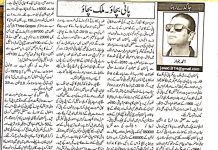By Kalim Farooqui
Pakistan of today has successfully overcome all major and recent hurdles and is very much on a progressive trail. The Global Recession of 2001, the Asian Financial Crises, the post 9/11 involvement as an ally and a front line state fighting the “War on Terror” and the resulting security situation rendering enormous difficulties, specially to the business community, is now almost history. Then, Pakistan was mostly making global headlines and not for good reasons having lost over 50 thousand of its citizens and a loss to the national exchequer of over 8 Billion Dollars; all within a short span. For any nation, and that too developing, to have gone through such a course in its short history would have translated into complete anarchy, if not a total collapse and without any recourse as we are currently, and virtually on a daily basis, witnessing in some of the Middle East countries. The most to be affected were the wheels of the economy which were fast moving towards a grinding halt for lack of activities in trading and investment related deals with the outside world. Not so anymore. Pakistan is where hope has always triumphed over despair in such conflicting and inconsistent moments in a nation’s history. The resilience and the spirit with which Pakistan has bounced back is evident from the fast moving and ascending economic indicators which is now being recognised globally. It speaks volumes about the perseverance and determination of Pakistan’s business community in particular, and the nation as a whole. It is now common knowledge that the stock exchange of Pakistan is amongst the best performing in South Asia crossing the psychological barrier of 35,000 for the first time and advancing almost 16% in a year. With the government increasing its Public Sector Development Plan (PSDP) by almost 27% to Rupees 1.5 Trillion and including projects related to energy, dams, roads and motorways, housing, industrial parks and the like, it is expected to rise further. Industrial units dealing in cement, steel and the like have benefited by the growth in construction sector by almost 15% with some announcing enhancement in their production capacities. A steel industry from the private sector is doubling its steel production to 500,000 tons next year by injecting additional equity. Dividends pay offs, and especially by MNC’s in some cases have exceeded 100% per annum. A recent article “Rise of Pakistan just a matter of time” by David M Darst of Morgan Stanley and an author of 11 books having PhD from Yale, while discussing the strong fundamentals of Pakistan Stock Market says “with 31% returns in dollar terms, Pakistan led the world markets in 2014”. The government also envisages the establishment of Export Processing Zones (EPZ’s) throughout Pakistan and for which “Special Economic Zones (Amend) Bill, 2015” was introduced earlier this year. It provides for exemption for 10 years from all taxes on income for enterprises commencing commercial production by June, 30, 2020. Last week, State Bank of Pakistan announced a 25 basis point (bps) cut in its policy rate on improved macroeconomic conditions. With this cut the policy rate has reached historical lowest rate to now 5.75 percent. Pakistan with its 190 Million population (world’s 6th largest) and a land of 800,000 square kilometers, over 1000 km of coastline and with abundant natural resources stands as the 26th largest economy of the world in terms of purchasing power parity (PPP) and 40th largest in absolute dollar terms and expanding at a projected rate of almost 5%. Encouraging reports are surfacing in the Capital Markets around the world drawing attention to the potential which Pakistan holds. “Best Hidden Frontier Market”, “Pakistan: The Next Columbia Success Story?”, are amongst the title stories appearing in the likes of Forbes and Bloomberg News. According to Goldman Sachs investment bank and economist Jim O’Neill in a research paper has identified Pakistan amongst one of the Next Eleven countries having a high potential of becoming, along with the BRICS, the world’s largest economies in the 21st century. Their assumption is based on the promising outlooks for investment and future growth for reasons of economic liberalisation which includes long awaited privatisation of public sector corporations, decrease in budget deficits and gradual increase in foreign currency reserves. Overseas Investors Chamber of Commerce and Industry (OICCI) has this month shared results of its latest Business Confidence Index (BCI) Survey, which reached a record level of 36% positive, showing a further 14% improvement announced in November 2015. Above all, the investment pledges for what is termed as China-Pakistan Economic Corridor (CPEC), where China has agreed to invest in excess of 45 Billion Dollars for infrastructure improvement and towards which, no less than the President of China himself visited Pakistan last year to witness the signing of the agreements. This is seen by many as a game changer for Pakistan in the days ahead and alerting many world capitals to now see Pakistan as a potential destiny for trade and investments. Sector wise, 50% of Pakistan’s GDP is equally divided between Agriculture and Industry while the remaining 50% contributed by the Services Sector. In all these sectors, Germany can play a vital role especially in the Industrial and Services Sector. Pakistan is blessed with abundant natural resources which, besides ample virgin land, has copper fields, salt ranges, coal mines, gas reserves and the like and consequently has well established industrial base for textiles, cement, fertiliser, steel, sugar, engineering goods, leather and the list continues with industrial units providing value added goods. Information Technology exports from Pakistan is witnessing a 40% growth each year with current export at $2 Billion. Amongst its paramount resource is its youth with almost 60% under the age of 30 years. No wonder that World Start-up report, a US based organisation in the Silicon Valley where 12,500 Pakistanis are already employed, while evaluating countries of the region, points to the fact that Pakistan is the most favoured destination for starting new businesses. According to them, Pakistan has 30 million internet users, 135 million Mobile subscriptions, 7 million smart phone users with almost 15 million face book users; all in recent years. Free Trade Agreements (FTA’s) are in place with Malaysia, Indonesia, China and Sri Lanka while with South Korea and Thailand are being negotiated and is expected to be soon finalised. Besides, businesses in Pakistan can now also eye the Iranian market which after decades of sanctions is opening up having a market base with a population of 80 Million and proven oil reserves of nearly 1.5 Billion barrels; allowing Iran to start trading with the outside world and in return meet its need for the critically needed infrastructure and other requirements necessitating foreign exchange. Pakistan is strategically located with Iran, Afghanistan and the Central Asian States to its West and India and China to its East making it an ideal hub for doing business. Representatives of German related businesses have therefore taken the lead to establish a Joint Chamber of Commerce and Industry. Economic and financial development cooperation between the two nations goes back to 1961. Germany is now Pakistan’s 4th largest trading partner with several internationally known German Companies operating in Pakistan for decades. The German government is also actively involved in Pakistan’s socio-economic development providing assistance in the badly needed social sectors like health and education through their organisations such as KfW and GIZ. It was in 1961 that the first state visit ever by a Pakistani Head of State was made to meet his counterpart in Germany who recognised Pakistan as an example of successful development policy in a developing country and partnered with Pakistan to launch an industrial development program; hence becoming one of the first economic partner of Germany. It may even surprise many that Pakistan, in 1963 had loaned 120 Million Rupees to Germany for development when the parity of the then Deutsche Mark was about equal to the Pakistani Rupee. Mutual cooperation was followed by a prolonged and heavy industrial programs by Germany to aid Pakistan in its industrial growth, attracting many multinationals from Germany to establish their footprints in Pakistan and operating successfully even now. In a visit to Germany by the Sind Board of Investment (SBOI) along with several conglomerates from the business community earlier this month, more MOU’S have been signed for establishing production units which also includes one from the automotive sector. Thus, the proven track record of Pakistan with Germany with respect to mutual understanding and cooperation is again being revitalised and the launching of the joint German Pakistan Chamber of Commerce & Industry (GPCCI) stands testament to the fact that Pakistan is back on its progressive trajectory. As a consequence, Pakistan will be partnering with Germany which is the largest economy in Europe and the 4th largest in the world. In 2014, Germany recorded the highest trade surplus in the world worth $285 billion, making it the biggest capital exporter globally. Launching therefore of GPCCI, is a timely decision with an appropriate partner at a very opportune moment.







